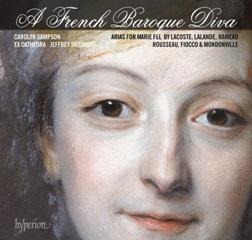A French Baroque Diva - Arias for Marie Fel (2014)
A French Baroque Diva - Arias for Marie Fel (2014)

Louis Lacoste 1.Ah! quand reviendront nos beaux jours? (Prologue Scene 1 from Philomèle)[9'01] Michel-Richard de Lalande 2.Regna terrae (Movement 5 of Exsurgat Deus, S71)[2'28] 3.Sinfonie (Movement 1 of Te Deum laudamus, S32)[1'48] 4.Tu rex gloriae (Movement 8 of Te Deum laudamus, S32)[1'58] 5.Tu ad liberandum suscepturus hominem (Movement 9 of Te Deum laudamus, S32)[3'22] Jean-Jacques Rousseau - Salve regina[9'39] 6.Salve regina, salve mater[4'32] 7.Ad te clamamus, exsules, filii Evae[0'50] 8.O clemens, o pia[4'17] Jean-Philippe Rameau 9.Un tendre intérêt vous appelle – Tristes apprêts (Act 1 Scenes 2-3 from Castor et Pollux)[7'03] 10.Amour, lance tes traits (Act 3 Scene 4 from Platée)[3'07] Jean-Joseph Cassanéa de Mondonville 11.Gasouillats auzeléts (Act 1 Scene 2 from Daphnis et Alcimadure)[3'48] Joseph Hector Fiocco 12.Laudate pueri (Part 1 of Laudate pueri)[1'32] 13.A solis ortu (Part 3 of Laudate pueri)[3'19] 14.Alleluia (Part 4 of Laudate pueri)[1'53] Jean-Joseph Cassanéa de Mondonville 15.Venite, adoremus (Movement 4 of Venite, exsultemus)[3'04] Jean-Philippe Rameau - La lyre enchantée[12'51] 16.Accordez vos sons et vos pas[3'44] 17.Gavotte: Lyre enchanteresse[1'52] 18.Écoutons … D'un doux frémissement[1'54] 19.Vole, Amour, prête-moi tes armes[3'36] 20.Contredanse[1'45] Michel-Richard de Lalande 21.Viderunt omnes termini terrae (Movement 5 of Cantate Domino, S72) Jean-Joseph Cassanéa de Mondonville 22.Hodie si vocem (Movement 6 of Venite, exsultemus)[2'53] Carolyn Sampson (soprano) Ex Cathedra (ensemble) Jeffrey Skidmore (conductor)
A welcome return of Carolyn Sampson and Ex Cathedra to Hyperion, performing the rich, fulsome music of the French Baroque. Their recording of love songs from Rameau’s operas was hugely acclaimed for Sampson’s stylish, fluid, seductive performances, and ten years later her artistry is even more dazzling.
This album is of particular interest as rather than concentrating on one composer it showcases the works written for the premiere soprano of the day, Marie Fel. Voltaire called her his ‘adorable nightingale’. For d’Aquin, she was an enchanted being. Marie Fel was the soprano who held an entire generation spellbound at the Paris Opéra and at Louis XV’s court during one of the most glorious periods of French music. With a voice described as ‘pure, charming, silvery’ (La Borde), ‘touching and sublime’ (Grimm) and ‘always lovely, always seductive’ (d’Aquin), she inspired some of Jean-Philippe Rameau’s finest music and introduced a whole new level of virtuosity and expression into the French singing tradition. Her long, triumphant career is traced through this fascinating recording. ---hyperion-records.co.uk
CDs dedicated to the eighteenth-century virtuosos who peopled the Italian operas of their day have become very common; single issues concentrating on the great exponents and creators of the parallel French repertory remain rare. The accomplished, stylistically informed British soprano Carolyn Sampson offers a highly worthy study of — and tribute to — her great predecessor Marie Fel (1713–94), a key figure for Rameau, Jean-Jacques Rousseau and others. Fel, born in Bordeaux to a highly musical family, made her initial bow at the future Opéra — then still called the Académie Royale de Musique — in 1734, when she had just turned twenty-one. She sang the Prologue (“Ah! quand reviendront nos beaux jours?”) for a revival of Louis Lacoste’s 1705 Philomèle. That number — declaimed lyric accompanied recitative with a choral midsection — opens Sampson’s recital. Fel gained increased virtuosity and confidence after study with the Italian soprano Christina Somis, which allowed her to move beyond ingénues to leading parts both tragic and comic. Her creation of La Folie in Rameau’s Platée — a diva role if ever there was one — transformed her into Paris’s leading soprano for the following quarter century. Fel retired from stage work in 1758 but continued her already established work singing religious music with Le Concert Spirituel until 1769. Some of the present disc’s most compelling discoveries derive from Joseph Hector Fiocco’s psalm setting “Laudate pueri”; Sampson here sings Fel’s original ornamentation.
Sampson is no stranger to recording studios. Foremost in her opera repertory have been composers such as Purcell, Handel, Rameau and Campra; she also sings Stravinsky’s Anne Trulove, a neoclassical exception that proves the rule. Sampson wields a light, bright lyric soprano with the requisite agility to conquer almost all of the hurdles here. (A few high-lying melismatic runs stretch her.) Fel gave the premieres of music not only in French and Latin but in Occitan, for 1754’s dialect-set Daphnis et Alcimadure, by Jean-Joseph Cassanéa de Mondonville (like Fel, from southern France). Alcimadure’s sparkling “Gasouillats auzeléts” is here, along with two contrasting slow, solemnly beautiful movements from Mondonville’s 1740 motet Venite, Exsultemus. Occitan lies outside my professional competence, but Sampson’s French enunciation is clear and well practiced. The members of Jeffrey Skidmore’s precise instrumental and choral ensemble, Ex Cathedra, prove excellent collaborators. This CD should please anyone intrigued by late French Baroque music’s special sound world. ---David Shengold, operanews.com
download (mp3 @320 kbs):
yandex 4shared mega mediafire cloudmailru uplea








